X-ray Radiography in Dentistry: Techniques, CT, CBCT, Effects
VerifiedAdded on 2023/06/05
|25
|11050
|317
Report
AI Summary
This report delves into the multifaceted world of X-ray radiography, beginning with its historical origins and tracing the evolution of imaging techniques. It explores the fundamental principles of X-ray production and its application in dentistry, particularly focusing on the use of intra-oral peri-apical radiographs, Radio visiography (RVG), Cone-beam computed tomography (CBCT), and Computed Tomography (CT) in endodontic diagnosis and treatment planning. The report highlights the significance of these imaging modalities in visualizing dental anatomy, surrounding structures, and pathologies. Furthermore, the report discusses the effects of ionizing radiation, differentiating between stochastic and deterministic effects, and emphasizes the importance of radiation protection guidelines, including dose reduction strategies and the selection of appropriate imaging protocols. The report also presents the history of CT and CBCT and the advantages of CBCT in dental imaging and the role of CBCT in various dental specialties, as well as its increasing importance in treatment planning and diagnosis. This comprehensive overview provides valuable insights into the application, benefits, and safety considerations associated with X-ray radiography in the field of dentistry.
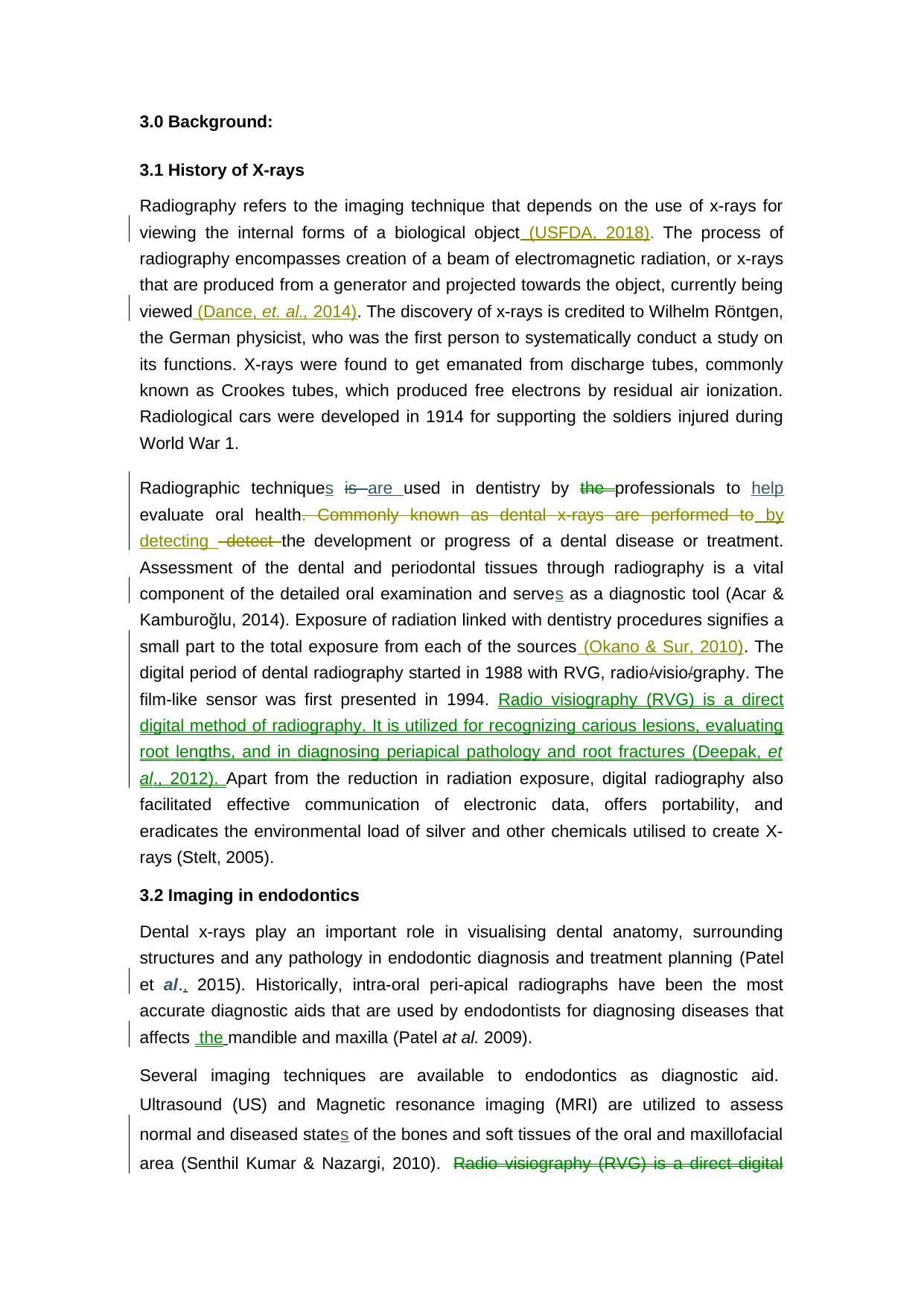
3.0 Background:
3.1 History of X-rays
Radiography refers to the imaging technique that depends on the use of x-rays for
viewing the internal forms of a biological object (USFDA, 2018). The process of
radiography encompasses creation of a beam of electromagnetic radiation, or x-rays
that are produced from a generator and projected towards the object, currently being
viewed (Dance, et. al., 2014). The discovery of x-rays is credited to Wilhelm Röntgen,
the German physicist, who was the first person to systematically conduct a study on
its functions. X-rays were found to get emanated from discharge tubes, commonly
known as Crookes tubes, which produced free electrons by residual air ionization.
Radiological cars were developed in 1914 for supporting the soldiers injured during
World War 1.
Radiographic techniques is are used in dentistry by the professionals to help
evaluate oral health. Commonly known as dental x-rays are performed to by
detecting detect the development or progress of a dental disease or treatment.
Assessment of the dental and periodontal tissues through radiography is a vital
component of the detailed oral examination and serves as a diagnostic tool (Acar &
Kamburoğlu, 2014). Exposure of radiation linked with dentistry procedures signifies a
small part to the total exposure from each of the sources (Okano & Sur, 2010). The
digital period of dental radiography started in 1988 with RVG, radio/visio/graphy. The
film-like sensor was first presented in 1994. Radio visiography (RVG) is a direct
digital method of radiography. It is utilized for recognizing carious lesions, evaluating
root lengths, and in diagnosing periapical pathology and root fractures (Deepak, et
al., 2012). Apart from the reduction in radiation exposure, digital radiography also
facilitated effective communication of electronic data, offers portability, and
eradicates the environmental load of silver and other chemicals utilised to create X-
rays (Stelt, 2005).
3.2 Imaging in endodontics
Dental x-rays play an important role in visualising dental anatomy, surrounding
structures and any pathology in endodontic diagnosis and treatment planning (Patel
et al., 2015). Historically, intra-oral peri-apical radiographs have been the most
accurate diagnostic aids that are used by endodontists for diagnosing diseases that
affects the mandible and maxilla (Patel at al. 2009).
Several imaging techniques are available to endodontics as diagnostic aid.
Ultrasound (US) and Magnetic resonance imaging (MRI) are utilized to assess
normal and diseased states of the bones and soft tissues of the oral and maxillofacial
area (Senthil Kumar & Nazargi, 2010). Radio visiography (RVG) is a direct digital
3.1 History of X-rays
Radiography refers to the imaging technique that depends on the use of x-rays for
viewing the internal forms of a biological object (USFDA, 2018). The process of
radiography encompasses creation of a beam of electromagnetic radiation, or x-rays
that are produced from a generator and projected towards the object, currently being
viewed (Dance, et. al., 2014). The discovery of x-rays is credited to Wilhelm Röntgen,
the German physicist, who was the first person to systematically conduct a study on
its functions. X-rays were found to get emanated from discharge tubes, commonly
known as Crookes tubes, which produced free electrons by residual air ionization.
Radiological cars were developed in 1914 for supporting the soldiers injured during
World War 1.
Radiographic techniques is are used in dentistry by the professionals to help
evaluate oral health. Commonly known as dental x-rays are performed to by
detecting detect the development or progress of a dental disease or treatment.
Assessment of the dental and periodontal tissues through radiography is a vital
component of the detailed oral examination and serves as a diagnostic tool (Acar &
Kamburoğlu, 2014). Exposure of radiation linked with dentistry procedures signifies a
small part to the total exposure from each of the sources (Okano & Sur, 2010). The
digital period of dental radiography started in 1988 with RVG, radio/visio/graphy. The
film-like sensor was first presented in 1994. Radio visiography (RVG) is a direct
digital method of radiography. It is utilized for recognizing carious lesions, evaluating
root lengths, and in diagnosing periapical pathology and root fractures (Deepak, et
al., 2012). Apart from the reduction in radiation exposure, digital radiography also
facilitated effective communication of electronic data, offers portability, and
eradicates the environmental load of silver and other chemicals utilised to create X-
rays (Stelt, 2005).
3.2 Imaging in endodontics
Dental x-rays play an important role in visualising dental anatomy, surrounding
structures and any pathology in endodontic diagnosis and treatment planning (Patel
et al., 2015). Historically, intra-oral peri-apical radiographs have been the most
accurate diagnostic aids that are used by endodontists for diagnosing diseases that
affects the mandible and maxilla (Patel at al. 2009).
Several imaging techniques are available to endodontics as diagnostic aid.
Ultrasound (US) and Magnetic resonance imaging (MRI) are utilized to assess
normal and diseased states of the bones and soft tissues of the oral and maxillofacial
area (Senthil Kumar & Nazargi, 2010). Radio visiography (RVG) is a direct digital
Paraphrase This Document
Need a fresh take? Get an instant paraphrase of this document with our AI Paraphraser
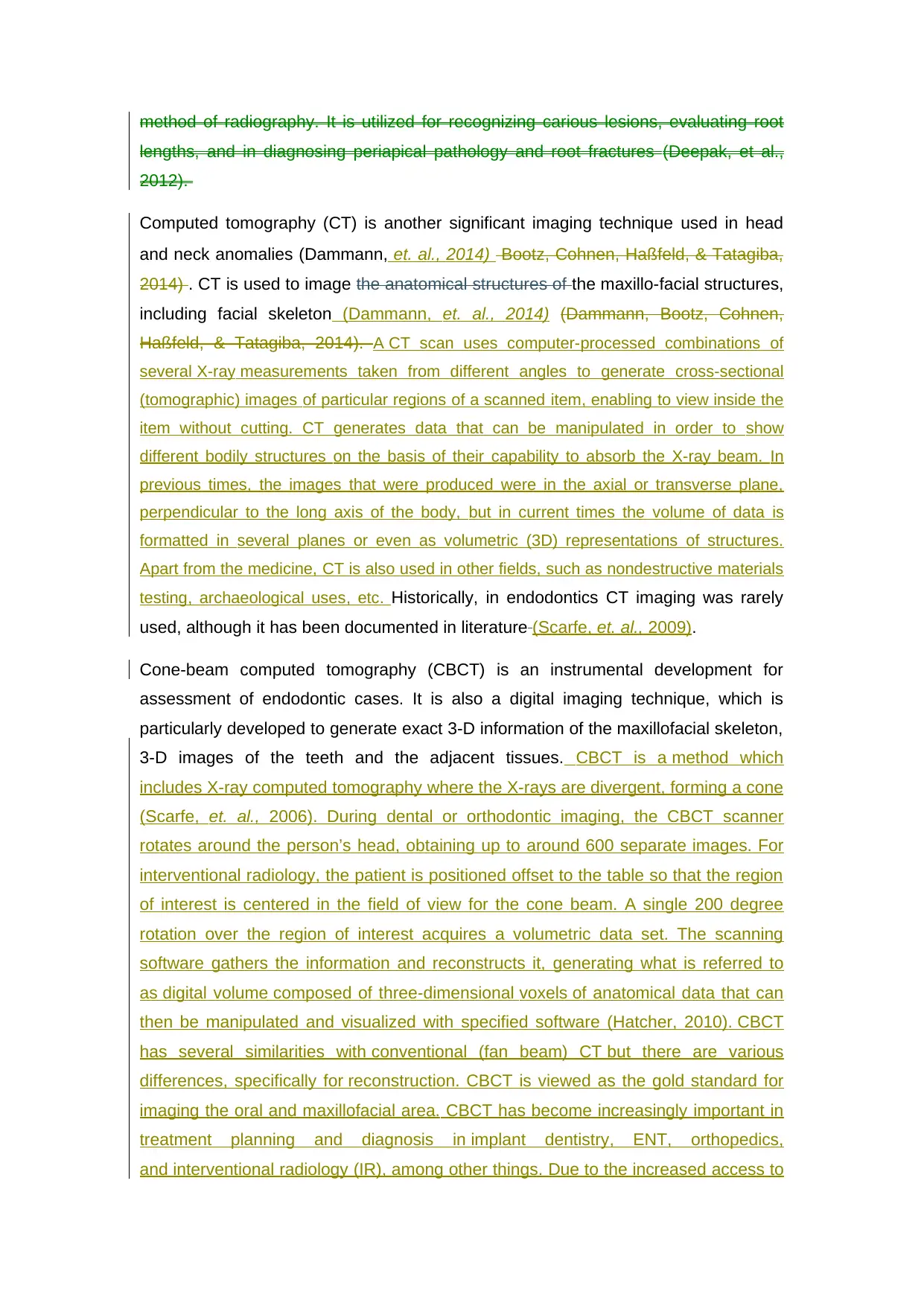
method of radiography. It is utilized for recognizing carious lesions, evaluating root
lengths, and in diagnosing periapical pathology and root fractures (Deepak, et al.,
2012).
Computed tomography (CT) is another significant imaging technique used in head
and neck anomalies (Dammann, et. al., 2014) Bootz, Cohnen, Haßfeld, & Tatagiba,
2014) . CT is used to image the anatomical structures of the maxillo-facial structures,
including facial skeleton (Dammann, et. al., 2014) (Dammann, Bootz, Cohnen,
Haßfeld, & Tatagiba, 2014). A CT scan uses computer-processed combinations of
several X-ray measurements taken from different angles to generate cross-sectional
(tomographic) images of particular regions of a scanned item, enabling to view inside the
item without cutting. CT generates data that can be manipulated in order to show
different bodily structures on the basis of their capability to absorb the X-ray beam. In
previous times, the images that were produced were in the axial or transverse plane,
perpendicular to the long axis of the body, but in current times the volume of data is
formatted in several planes or even as volumetric (3D) representations of structures.
Apart from the medicine, CT is also used in other fields, such as nondestructive materials
testing, archaeological uses, etc. Historically, in endodontics CT imaging was rarely
used, although it has been documented in literature (Scarfe, et. al., 2009).
Cone-beam computed tomography (CBCT) is an instrumental development for
assessment of endodontic cases. It is also a digital imaging technique, which is
particularly developed to generate exact 3-D information of the maxillofacial skeleton,
3-D images of the teeth and the adjacent tissues. CBCT is a method which
includes X-ray computed tomography where the X-rays are divergent, forming a cone
(Scarfe, et. al., 2006). During dental or orthodontic imaging, the CBCT scanner
rotates around the person’s head, obtaining up to around 600 separate images. For
interventional radiology, the patient is positioned offset to the table so that the region
of interest is centered in the field of view for the cone beam. A single 200 degree
rotation over the region of interest acquires a volumetric data set. The scanning
software gathers the information and reconstructs it, generating what is referred to
as digital volume composed of three-dimensional voxels of anatomical data that can
then be manipulated and visualized with specified software (Hatcher, 2010). CBCT
has several similarities with conventional (fan beam) CT but there are various
differences, specifically for reconstruction. CBCT is viewed as the gold standard for
imaging the oral and maxillofacial area. CBCT has become increasingly important in
treatment planning and diagnosis in implant dentistry, ENT, orthopedics,
and interventional radiology (IR), among other things. Due to the increased access to
lengths, and in diagnosing periapical pathology and root fractures (Deepak, et al.,
2012).
Computed tomography (CT) is another significant imaging technique used in head
and neck anomalies (Dammann, et. al., 2014) Bootz, Cohnen, Haßfeld, & Tatagiba,
2014) . CT is used to image the anatomical structures of the maxillo-facial structures,
including facial skeleton (Dammann, et. al., 2014) (Dammann, Bootz, Cohnen,
Haßfeld, & Tatagiba, 2014). A CT scan uses computer-processed combinations of
several X-ray measurements taken from different angles to generate cross-sectional
(tomographic) images of particular regions of a scanned item, enabling to view inside the
item without cutting. CT generates data that can be manipulated in order to show
different bodily structures on the basis of their capability to absorb the X-ray beam. In
previous times, the images that were produced were in the axial or transverse plane,
perpendicular to the long axis of the body, but in current times the volume of data is
formatted in several planes or even as volumetric (3D) representations of structures.
Apart from the medicine, CT is also used in other fields, such as nondestructive materials
testing, archaeological uses, etc. Historically, in endodontics CT imaging was rarely
used, although it has been documented in literature (Scarfe, et. al., 2009).
Cone-beam computed tomography (CBCT) is an instrumental development for
assessment of endodontic cases. It is also a digital imaging technique, which is
particularly developed to generate exact 3-D information of the maxillofacial skeleton,
3-D images of the teeth and the adjacent tissues. CBCT is a method which
includes X-ray computed tomography where the X-rays are divergent, forming a cone
(Scarfe, et. al., 2006). During dental or orthodontic imaging, the CBCT scanner
rotates around the person’s head, obtaining up to around 600 separate images. For
interventional radiology, the patient is positioned offset to the table so that the region
of interest is centered in the field of view for the cone beam. A single 200 degree
rotation over the region of interest acquires a volumetric data set. The scanning
software gathers the information and reconstructs it, generating what is referred to
as digital volume composed of three-dimensional voxels of anatomical data that can
then be manipulated and visualized with specified software (Hatcher, 2010). CBCT
has several similarities with conventional (fan beam) CT but there are various
differences, specifically for reconstruction. CBCT is viewed as the gold standard for
imaging the oral and maxillofacial area. CBCT has become increasingly important in
treatment planning and diagnosis in implant dentistry, ENT, orthopedics,
and interventional radiology (IR), among other things. Due to the increased access to
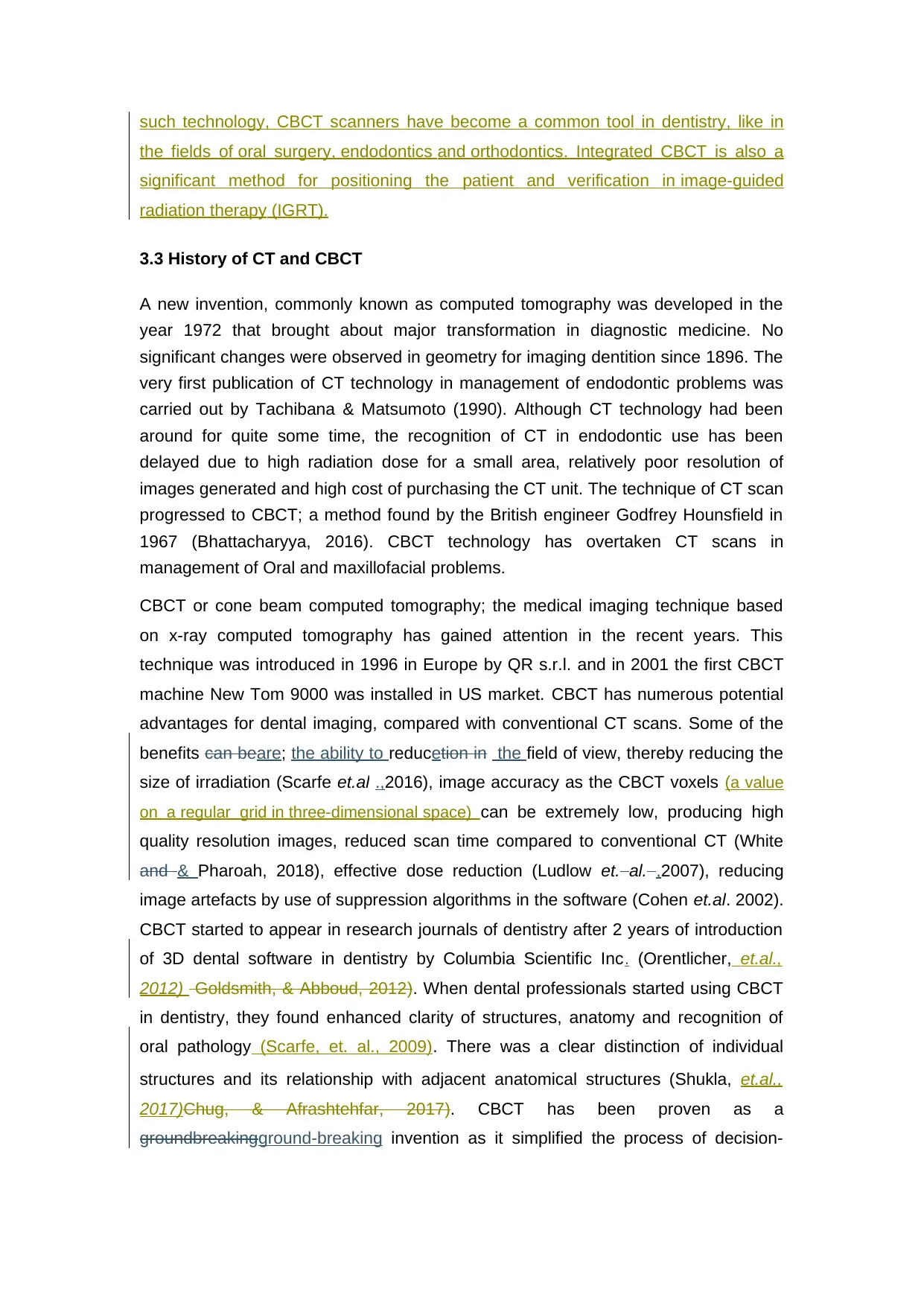
such technology, CBCT scanners have become a common tool in dentistry, like in
the fields of oral surgery, endodontics and orthodontics. Integrated CBCT is also a
significant method for positioning the patient and verification in image-guided
radiation therapy (IGRT).
3.3 History of CT and CBCT
A new invention, commonly known as computed tomography was developed in the
year 1972 that brought about major transformation in diagnostic medicine. No
significant changes were observed in geometry for imaging dentition since 1896. The
very first publication of CT technology in management of endodontic problems was
carried out by Tachibana & Matsumoto (1990). Although CT technology had been
around for quite some time, the recognition of CT in endodontic use has been
delayed due to high radiation dose for a small area, relatively poor resolution of
images generated and high cost of purchasing the CT unit. The technique of CT scan
progressed to CBCT; a method found by the British engineer Godfrey Hounsfield in
1967 (Bhattacharyya, 2016). CBCT technology has overtaken CT scans in
management of Oral and maxillofacial problems.
CBCT or cone beam computed tomography; the medical imaging technique based
on x-ray computed tomography has gained attention in the recent years. This
technique was introduced in 1996 in Europe by QR s.r.l. and in 2001 the first CBCT
machine New Tom 9000 was installed in US market. CBCT has numerous potential
advantages for dental imaging, compared with conventional CT scans. Some of the
benefits can beare; the ability to reducetion in the field of view, thereby reducing the
size of irradiation (Scarfe et.al .,2016), image accuracy as the CBCT voxels (a value
on a regular grid in three-dimensional space) can be extremely low, producing high
quality resolution images, reduced scan time compared to conventional CT (White
and & Pharoah, 2018), effective dose reduction (Ludlow et. al. ,2007), reducing
image artefacts by use of suppression algorithms in the software (Cohen et.al. 2002).
CBCT started to appear in research journals of dentistry after 2 years of introduction
of 3D dental software in dentistry by Columbia Scientific Inc. (Orentlicher, et.al.,
2012) Goldsmith, & Abboud, 2012). When dental professionals started using CBCT
in dentistry, they found enhanced clarity of structures, anatomy and recognition of
oral pathology (Scarfe, et. al., 2009). There was a clear distinction of individual
structures and its relationship with adjacent anatomical structures (Shukla, et.al.,
2017)Chug, & Afrashtehfar, 2017). CBCT has been proven as a
groundbreakingground-breaking invention as it simplified the process of decision-
the fields of oral surgery, endodontics and orthodontics. Integrated CBCT is also a
significant method for positioning the patient and verification in image-guided
radiation therapy (IGRT).
3.3 History of CT and CBCT
A new invention, commonly known as computed tomography was developed in the
year 1972 that brought about major transformation in diagnostic medicine. No
significant changes were observed in geometry for imaging dentition since 1896. The
very first publication of CT technology in management of endodontic problems was
carried out by Tachibana & Matsumoto (1990). Although CT technology had been
around for quite some time, the recognition of CT in endodontic use has been
delayed due to high radiation dose for a small area, relatively poor resolution of
images generated and high cost of purchasing the CT unit. The technique of CT scan
progressed to CBCT; a method found by the British engineer Godfrey Hounsfield in
1967 (Bhattacharyya, 2016). CBCT technology has overtaken CT scans in
management of Oral and maxillofacial problems.
CBCT or cone beam computed tomography; the medical imaging technique based
on x-ray computed tomography has gained attention in the recent years. This
technique was introduced in 1996 in Europe by QR s.r.l. and in 2001 the first CBCT
machine New Tom 9000 was installed in US market. CBCT has numerous potential
advantages for dental imaging, compared with conventional CT scans. Some of the
benefits can beare; the ability to reducetion in the field of view, thereby reducing the
size of irradiation (Scarfe et.al .,2016), image accuracy as the CBCT voxels (a value
on a regular grid in three-dimensional space) can be extremely low, producing high
quality resolution images, reduced scan time compared to conventional CT (White
and & Pharoah, 2018), effective dose reduction (Ludlow et. al. ,2007), reducing
image artefacts by use of suppression algorithms in the software (Cohen et.al. 2002).
CBCT started to appear in research journals of dentistry after 2 years of introduction
of 3D dental software in dentistry by Columbia Scientific Inc. (Orentlicher, et.al.,
2012) Goldsmith, & Abboud, 2012). When dental professionals started using CBCT
in dentistry, they found enhanced clarity of structures, anatomy and recognition of
oral pathology (Scarfe, et. al., 2009). There was a clear distinction of individual
structures and its relationship with adjacent anatomical structures (Shukla, et.al.,
2017)Chug, & Afrashtehfar, 2017). CBCT has been proven as a
groundbreakingground-breaking invention as it simplified the process of decision-
⊘ This is a preview!⊘
Do you want full access?
Subscribe today to unlock all pages.

Trusted by 1+ million students worldwide
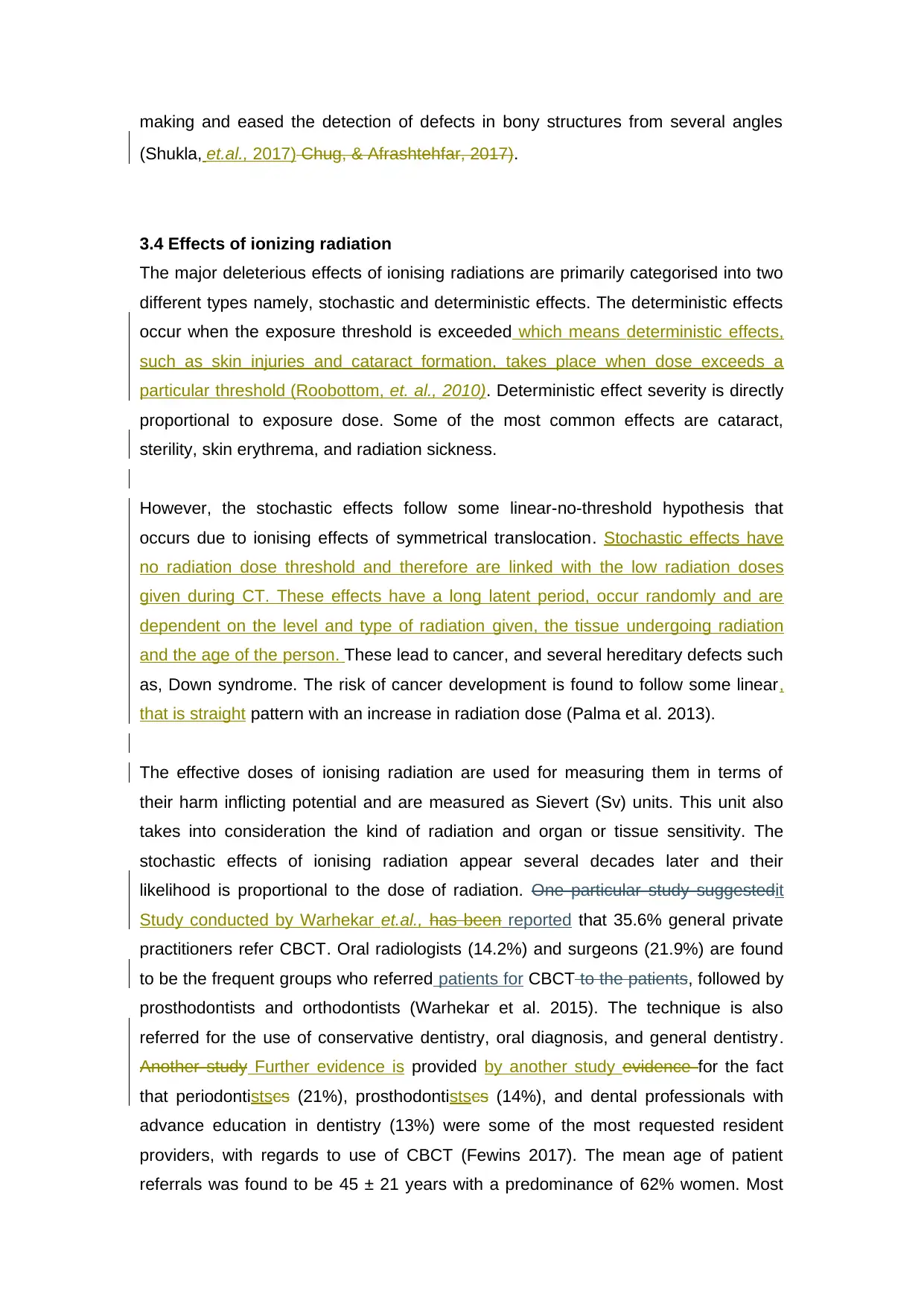
making and eased the detection of defects in bony structures from several angles
(Shukla, et.al., 2017) Chug, & Afrashtehfar, 2017).
3.4 Effects of ionizing radiation
The major deleterious effects of ionising radiations are primarily categorised into two
different types namely, stochastic and deterministic effects. The deterministic effects
occur when the exposure threshold is exceeded which means deterministic effects,
such as skin injuries and cataract formation, takes place when dose exceeds a
particular threshold (Roobottom, et. al., 2010). Deterministic effect severity is directly
proportional to exposure dose. Some of the most common effects are cataract,
sterility, skin erythrema, and radiation sickness.
However, the stochastic effects follow some linear-no-threshold hypothesis that
occurs due to ionising effects of symmetrical translocation. Stochastic effects have
no radiation dose threshold and therefore are linked with the low radiation doses
given during CT. These effects have a long latent period, occur randomly and are
dependent on the level and type of radiation given, the tissue undergoing radiation
and the age of the person. These lead to cancer, and several hereditary defects such
as, Down syndrome. The risk of cancer development is found to follow some linear,
that is straight pattern with an increase in radiation dose (Palma et al. 2013).
The effective doses of ionising radiation are used for measuring them in terms of
their harm inflicting potential and are measured as Sievert (Sv) units. This unit also
takes into consideration the kind of radiation and organ or tissue sensitivity. The
stochastic effects of ionising radiation appear several decades later and their
likelihood is proportional to the dose of radiation. One particular study suggestedit
Study conducted by Warhekar et.al., has been reported that 35.6% general private
practitioners refer CBCT. Oral radiologists (14.2%) and surgeons (21.9%) are found
to be the frequent groups who referred patients for CBCT to the patients, followed by
prosthodontists and orthodontists (Warhekar et al. 2015). The technique is also
referred for the use of conservative dentistry, oral diagnosis, and general dentistry.
Another study Further evidence is provided by another study evidence for the fact
that periodontistscs (21%), prosthodontistscs (14%), and dental professionals with
advance education in dentistry (13%) were some of the most requested resident
providers, with regards to use of CBCT (Fewins 2017). The mean age of patient
referrals was found to be 45 ± 21 years with a predominance of 62% women. Most
(Shukla, et.al., 2017) Chug, & Afrashtehfar, 2017).
3.4 Effects of ionizing radiation
The major deleterious effects of ionising radiations are primarily categorised into two
different types namely, stochastic and deterministic effects. The deterministic effects
occur when the exposure threshold is exceeded which means deterministic effects,
such as skin injuries and cataract formation, takes place when dose exceeds a
particular threshold (Roobottom, et. al., 2010). Deterministic effect severity is directly
proportional to exposure dose. Some of the most common effects are cataract,
sterility, skin erythrema, and radiation sickness.
However, the stochastic effects follow some linear-no-threshold hypothesis that
occurs due to ionising effects of symmetrical translocation. Stochastic effects have
no radiation dose threshold and therefore are linked with the low radiation doses
given during CT. These effects have a long latent period, occur randomly and are
dependent on the level and type of radiation given, the tissue undergoing radiation
and the age of the person. These lead to cancer, and several hereditary defects such
as, Down syndrome. The risk of cancer development is found to follow some linear,
that is straight pattern with an increase in radiation dose (Palma et al. 2013).
The effective doses of ionising radiation are used for measuring them in terms of
their harm inflicting potential and are measured as Sievert (Sv) units. This unit also
takes into consideration the kind of radiation and organ or tissue sensitivity. The
stochastic effects of ionising radiation appear several decades later and their
likelihood is proportional to the dose of radiation. One particular study suggestedit
Study conducted by Warhekar et.al., has been reported that 35.6% general private
practitioners refer CBCT. Oral radiologists (14.2%) and surgeons (21.9%) are found
to be the frequent groups who referred patients for CBCT to the patients, followed by
prosthodontists and orthodontists (Warhekar et al. 2015). The technique is also
referred for the use of conservative dentistry, oral diagnosis, and general dentistry.
Another study Further evidence is provided by another study evidence for the fact
that periodontistscs (21%), prosthodontistscs (14%), and dental professionals with
advance education in dentistry (13%) were some of the most requested resident
providers, with regards to use of CBCT (Fewins 2017). The mean age of patient
referrals was found to be 45 ± 21 years with a predominance of 62% women. Most
Paraphrase This Document
Need a fresh take? Get an instant paraphrase of this document with our AI Paraphraser
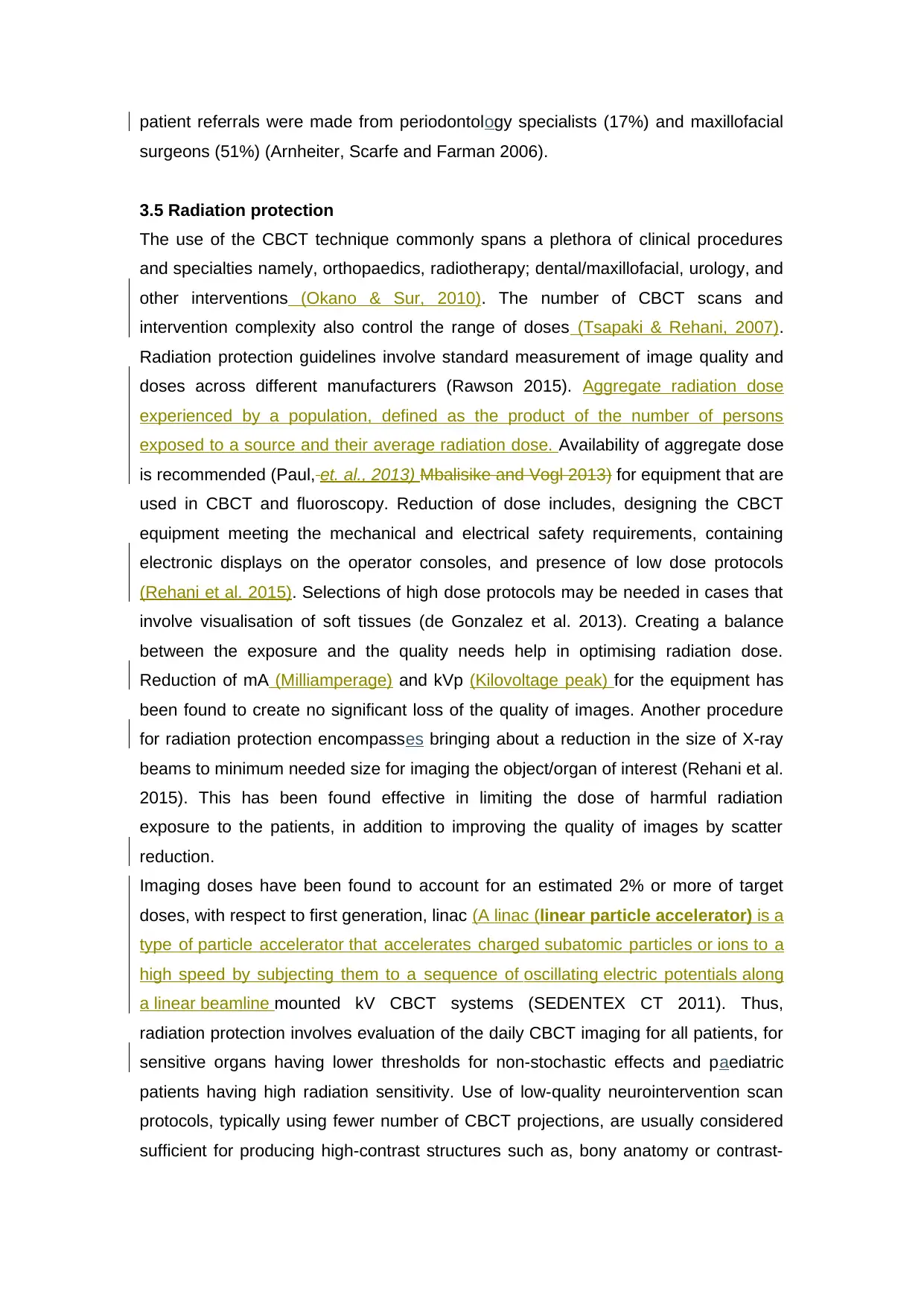
patient referrals were made from periodontology specialists (17%) and maxillofacial
surgeons (51%) (Arnheiter, Scarfe and Farman 2006).
3.5 Radiation protection
The use of the CBCT technique commonly spans a plethora of clinical procedures
and specialties namely, orthopaedics, radiotherapy; dental/maxillofacial, urology, and
other interventions (Okano & Sur, 2010). The number of CBCT scans and
intervention complexity also control the range of doses (Tsapaki & Rehani, 2007).
Radiation protection guidelines involve standard measurement of image quality and
doses across different manufacturers (Rawson 2015). Aggregate radiation dose
experienced by a population, defined as the product of the number of persons
exposed to a source and their average radiation dose. Availability of aggregate dose
is recommended (Paul, et. al., 2013) Mbalisike and Vogl 2013) for equipment that are
used in CBCT and fluoroscopy. Reduction of dose includes, designing the CBCT
equipment meeting the mechanical and electrical safety requirements, containing
electronic displays on the operator consoles, and presence of low dose protocols
(Rehani et al. 2015). Selections of high dose protocols may be needed in cases that
involve visualisation of soft tissues (de Gonzalez et al. 2013). Creating a balance
between the exposure and the quality needs help in optimising radiation dose.
Reduction of mA (Milliamperage) and kVp (Kilovoltage peak) for the equipment has
been found to create no significant loss of the quality of images. Another procedure
for radiation protection encompasses bringing about a reduction in the size of X-ray
beams to minimum needed size for imaging the object/organ of interest (Rehani et al.
2015). This has been found effective in limiting the dose of harmful radiation
exposure to the patients, in addition to improving the quality of images by scatter
reduction.
Imaging doses have been found to account for an estimated 2% or more of target
doses, with respect to first generation, linac (A linac (linear particle accelerator) is a
type of particle accelerator that accelerates charged subatomic particles or ions to a
high speed by subjecting them to a sequence of oscillating electric potentials along
a linear beamline mounted kV CBCT systems (SEDENTEX CT 2011). Thus,
radiation protection involves evaluation of the daily CBCT imaging for all patients, for
sensitive organs having lower thresholds for non-stochastic effects and paediatric
patients having high radiation sensitivity. Use of low-quality neurointervention scan
protocols, typically using fewer number of CBCT projections, are usually considered
sufficient for producing high-contrast structures such as, bony anatomy or contrast-
surgeons (51%) (Arnheiter, Scarfe and Farman 2006).
3.5 Radiation protection
The use of the CBCT technique commonly spans a plethora of clinical procedures
and specialties namely, orthopaedics, radiotherapy; dental/maxillofacial, urology, and
other interventions (Okano & Sur, 2010). The number of CBCT scans and
intervention complexity also control the range of doses (Tsapaki & Rehani, 2007).
Radiation protection guidelines involve standard measurement of image quality and
doses across different manufacturers (Rawson 2015). Aggregate radiation dose
experienced by a population, defined as the product of the number of persons
exposed to a source and their average radiation dose. Availability of aggregate dose
is recommended (Paul, et. al., 2013) Mbalisike and Vogl 2013) for equipment that are
used in CBCT and fluoroscopy. Reduction of dose includes, designing the CBCT
equipment meeting the mechanical and electrical safety requirements, containing
electronic displays on the operator consoles, and presence of low dose protocols
(Rehani et al. 2015). Selections of high dose protocols may be needed in cases that
involve visualisation of soft tissues (de Gonzalez et al. 2013). Creating a balance
between the exposure and the quality needs help in optimising radiation dose.
Reduction of mA (Milliamperage) and kVp (Kilovoltage peak) for the equipment has
been found to create no significant loss of the quality of images. Another procedure
for radiation protection encompasses bringing about a reduction in the size of X-ray
beams to minimum needed size for imaging the object/organ of interest (Rehani et al.
2015). This has been found effective in limiting the dose of harmful radiation
exposure to the patients, in addition to improving the quality of images by scatter
reduction.
Imaging doses have been found to account for an estimated 2% or more of target
doses, with respect to first generation, linac (A linac (linear particle accelerator) is a
type of particle accelerator that accelerates charged subatomic particles or ions to a
high speed by subjecting them to a sequence of oscillating electric potentials along
a linear beamline mounted kV CBCT systems (SEDENTEX CT 2011). Thus,
radiation protection involves evaluation of the daily CBCT imaging for all patients, for
sensitive organs having lower thresholds for non-stochastic effects and paediatric
patients having high radiation sensitivity. Use of low-quality neurointervention scan
protocols, typically using fewer number of CBCT projections, are usually considered
sufficient for producing high-contrast structures such as, bony anatomy or contrast-
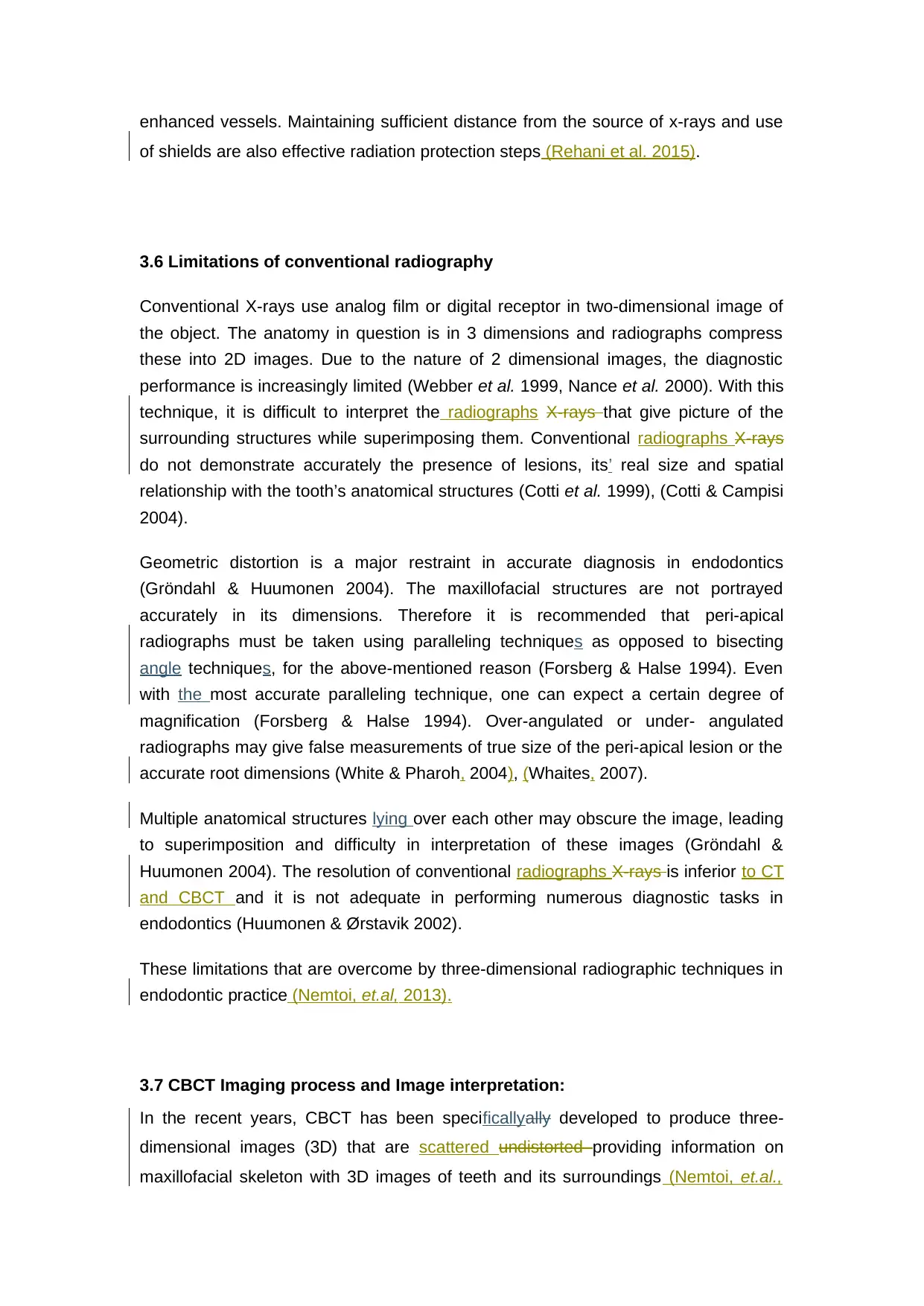
enhanced vessels. Maintaining sufficient distance from the source of x-rays and use
of shields are also effective radiation protection steps (Rehani et al. 2015).
3.6 Limitations of conventional radiography
Conventional X-rays use analog film or digital receptor in two-dimensional image of
the object. The anatomy in question is in 3 dimensions and radiographs compress
these into 2D images. Due to the nature of 2 dimensional images, the diagnostic
performance is increasingly limited (Webber et al. 1999, Nance et al. 2000). With this
technique, it is difficult to interpret the radiographs X-rays that give picture of the
surrounding structures while superimposing them. Conventional radiographs X-rays
do not demonstrate accurately the presence of lesions, its’ real size and spatial
relationship with the tooth’s anatomical structures (Cotti et al. 1999), (Cotti & Campisi
2004).
Geometric distortion is a major restraint in accurate diagnosis in endodontics
(Gröndahl & Huumonen 2004). The maxillofacial structures are not portrayed
accurately in its dimensions. Therefore it is recommended that peri-apical
radiographs must be taken using paralleling techniques as opposed to bisecting
angle techniques, for the above-mentioned reason (Forsberg & Halse 1994). Even
with the most accurate paralleling technique, one can expect a certain degree of
magnification (Forsberg & Halse 1994). Over-angulated or under- angulated
radiographs may give false measurements of true size of the peri-apical lesion or the
accurate root dimensions (White & Pharoh, 2004), (Whaites, 2007).
Multiple anatomical structures lying over each other may obscure the image, leading
to superimposition and difficulty in interpretation of these images (Gröndahl &
Huumonen 2004). The resolution of conventional radiographs X-rays is inferior to CT
and CBCT and it is not adequate in performing numerous diagnostic tasks in
endodontics (Huumonen & Ørstavik 2002).
These limitations that are overcome by three-dimensional radiographic techniques in
endodontic practice (Nemtoi, et.al, 2013).
3.7 CBCT Imaging process and Image interpretation:
In the recent years, CBCT has been specificallyally developed to produce three-
dimensional images (3D) that are scattered undistorted providing information on
maxillofacial skeleton with 3D images of teeth and its surroundings (Nemtoi, et.al.,
of shields are also effective radiation protection steps (Rehani et al. 2015).
3.6 Limitations of conventional radiography
Conventional X-rays use analog film or digital receptor in two-dimensional image of
the object. The anatomy in question is in 3 dimensions and radiographs compress
these into 2D images. Due to the nature of 2 dimensional images, the diagnostic
performance is increasingly limited (Webber et al. 1999, Nance et al. 2000). With this
technique, it is difficult to interpret the radiographs X-rays that give picture of the
surrounding structures while superimposing them. Conventional radiographs X-rays
do not demonstrate accurately the presence of lesions, its’ real size and spatial
relationship with the tooth’s anatomical structures (Cotti et al. 1999), (Cotti & Campisi
2004).
Geometric distortion is a major restraint in accurate diagnosis in endodontics
(Gröndahl & Huumonen 2004). The maxillofacial structures are not portrayed
accurately in its dimensions. Therefore it is recommended that peri-apical
radiographs must be taken using paralleling techniques as opposed to bisecting
angle techniques, for the above-mentioned reason (Forsberg & Halse 1994). Even
with the most accurate paralleling technique, one can expect a certain degree of
magnification (Forsberg & Halse 1994). Over-angulated or under- angulated
radiographs may give false measurements of true size of the peri-apical lesion or the
accurate root dimensions (White & Pharoh, 2004), (Whaites, 2007).
Multiple anatomical structures lying over each other may obscure the image, leading
to superimposition and difficulty in interpretation of these images (Gröndahl &
Huumonen 2004). The resolution of conventional radiographs X-rays is inferior to CT
and CBCT and it is not adequate in performing numerous diagnostic tasks in
endodontics (Huumonen & Ørstavik 2002).
These limitations that are overcome by three-dimensional radiographic techniques in
endodontic practice (Nemtoi, et.al, 2013).
3.7 CBCT Imaging process and Image interpretation:
In the recent years, CBCT has been specificallyally developed to produce three-
dimensional images (3D) that are scattered undistorted providing information on
maxillofacial skeleton with 3D images of teeth and its surroundings (Nemtoi, et.al.,
⊘ This is a preview!⊘
Do you want full access?
Subscribe today to unlock all pages.

Trusted by 1+ million students worldwide
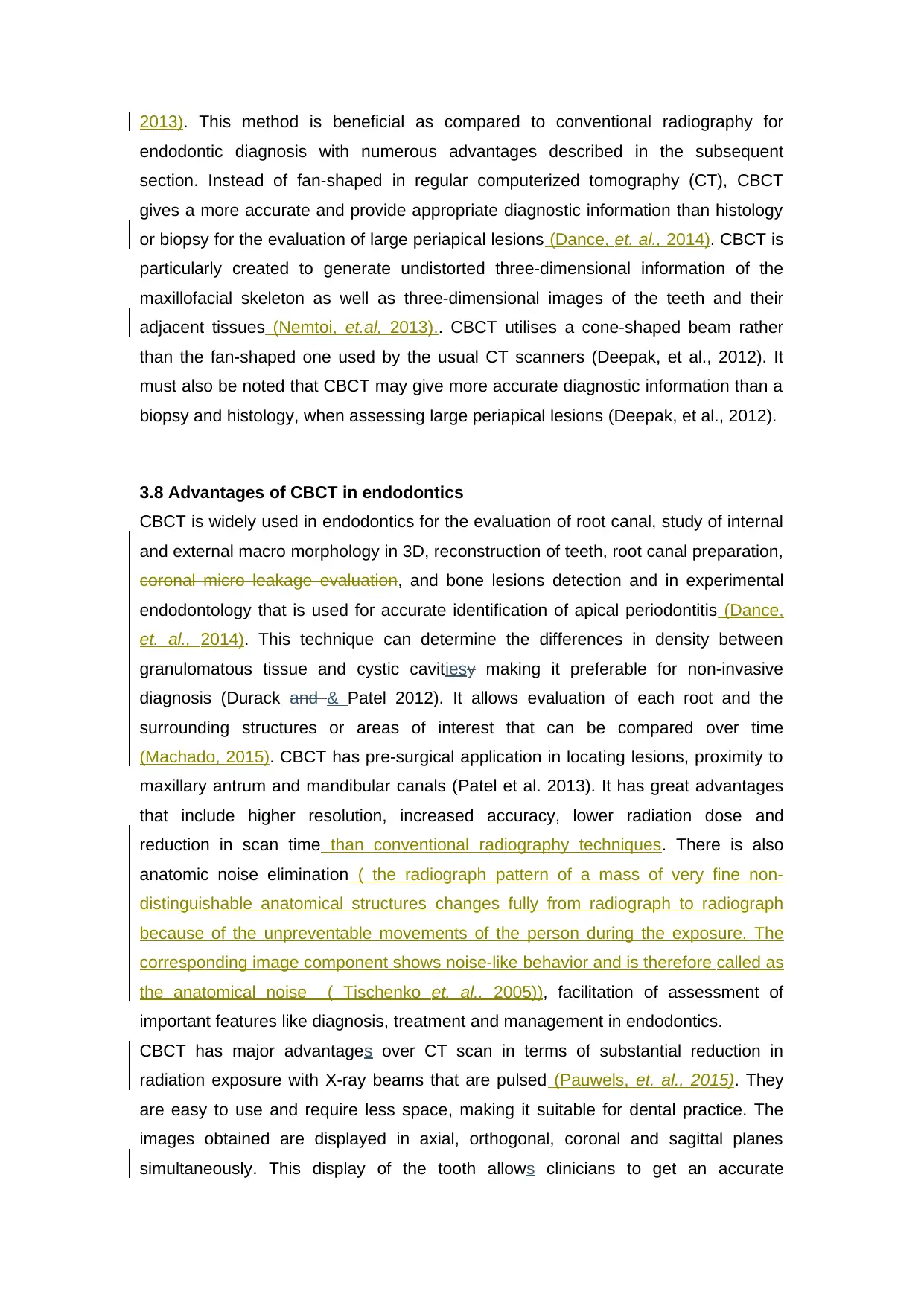
2013). This method is beneficial as compared to conventional radiography for
endodontic diagnosis with numerous advantages described in the subsequent
section. Instead of fan-shaped in regular computerized tomography (CT), CBCT
gives a more accurate and provide appropriate diagnostic information than histology
or biopsy for the evaluation of large periapical lesions (Dance, et. al., 2014). CBCT is
particularly created to generate undistorted three-dimensional information of the
maxillofacial skeleton as well as three-dimensional images of the teeth and their
adjacent tissues (Nemtoi, et.al, 2013).. CBCT utilises a cone-shaped beam rather
than the fan-shaped one used by the usual CT scanners (Deepak, et al., 2012). It
must also be noted that CBCT may give more accurate diagnostic information than a
biopsy and histology, when assessing large periapical lesions (Deepak, et al., 2012).
3.8 Advantages of CBCT in endodontics
CBCT is widely used in endodontics for the evaluation of root canal, study of internal
and external macro morphology in 3D, reconstruction of teeth, root canal preparation,
coronal micro leakage evaluation, and bone lesions detection and in experimental
endodontology that is used for accurate identification of apical periodontitis (Dance,
et. al., 2014). This technique can determine the differences in density between
granulomatous tissue and cystic cavitiesy making it preferable for non-invasive
diagnosis (Durack and & Patel 2012). It allows evaluation of each root and the
surrounding structures or areas of interest that can be compared over time
(Machado, 2015). CBCT has pre-surgical application in locating lesions, proximity to
maxillary antrum and mandibular canals (Patel et al. 2013). It has great advantages
that include higher resolution, increased accuracy, lower radiation dose and
reduction in scan time than conventional radiography techniques. There is also
anatomic noise elimination ( the radiograph pattern of a mass of very fine non-
distinguishable anatomical structures changes fully from radiograph to radiograph
because of the unpreventable movements of the person during the exposure. The
corresponding image component shows noise-like behavior and is therefore called as
the anatomical noise ( Tischenko et. al., 2005)), facilitation of assessment of
important features like diagnosis, treatment and management in endodontics.
CBCT has major advantages over CT scan in terms of substantial reduction in
radiation exposure with X-ray beams that are pulsed (Pauwels, et. al., 2015). They
are easy to use and require less space, making it suitable for dental practice. The
images obtained are displayed in axial, orthogonal, coronal and sagittal planes
simultaneously. This display of the tooth allows clinicians to get an accurate
endodontic diagnosis with numerous advantages described in the subsequent
section. Instead of fan-shaped in regular computerized tomography (CT), CBCT
gives a more accurate and provide appropriate diagnostic information than histology
or biopsy for the evaluation of large periapical lesions (Dance, et. al., 2014). CBCT is
particularly created to generate undistorted three-dimensional information of the
maxillofacial skeleton as well as three-dimensional images of the teeth and their
adjacent tissues (Nemtoi, et.al, 2013).. CBCT utilises a cone-shaped beam rather
than the fan-shaped one used by the usual CT scanners (Deepak, et al., 2012). It
must also be noted that CBCT may give more accurate diagnostic information than a
biopsy and histology, when assessing large periapical lesions (Deepak, et al., 2012).
3.8 Advantages of CBCT in endodontics
CBCT is widely used in endodontics for the evaluation of root canal, study of internal
and external macro morphology in 3D, reconstruction of teeth, root canal preparation,
coronal micro leakage evaluation, and bone lesions detection and in experimental
endodontology that is used for accurate identification of apical periodontitis (Dance,
et. al., 2014). This technique can determine the differences in density between
granulomatous tissue and cystic cavitiesy making it preferable for non-invasive
diagnosis (Durack and & Patel 2012). It allows evaluation of each root and the
surrounding structures or areas of interest that can be compared over time
(Machado, 2015). CBCT has pre-surgical application in locating lesions, proximity to
maxillary antrum and mandibular canals (Patel et al. 2013). It has great advantages
that include higher resolution, increased accuracy, lower radiation dose and
reduction in scan time than conventional radiography techniques. There is also
anatomic noise elimination ( the radiograph pattern of a mass of very fine non-
distinguishable anatomical structures changes fully from radiograph to radiograph
because of the unpreventable movements of the person during the exposure. The
corresponding image component shows noise-like behavior and is therefore called as
the anatomical noise ( Tischenko et. al., 2005)), facilitation of assessment of
important features like diagnosis, treatment and management in endodontics.
CBCT has major advantages over CT scan in terms of substantial reduction in
radiation exposure with X-ray beams that are pulsed (Pauwels, et. al., 2015). They
are easy to use and require less space, making it suitable for dental practice. The
images obtained are displayed in axial, orthogonal, coronal and sagittal planes
simultaneously. This display of the tooth allows clinicians to get an accurate
Paraphrase This Document
Need a fresh take? Get an instant paraphrase of this document with our AI Paraphraser
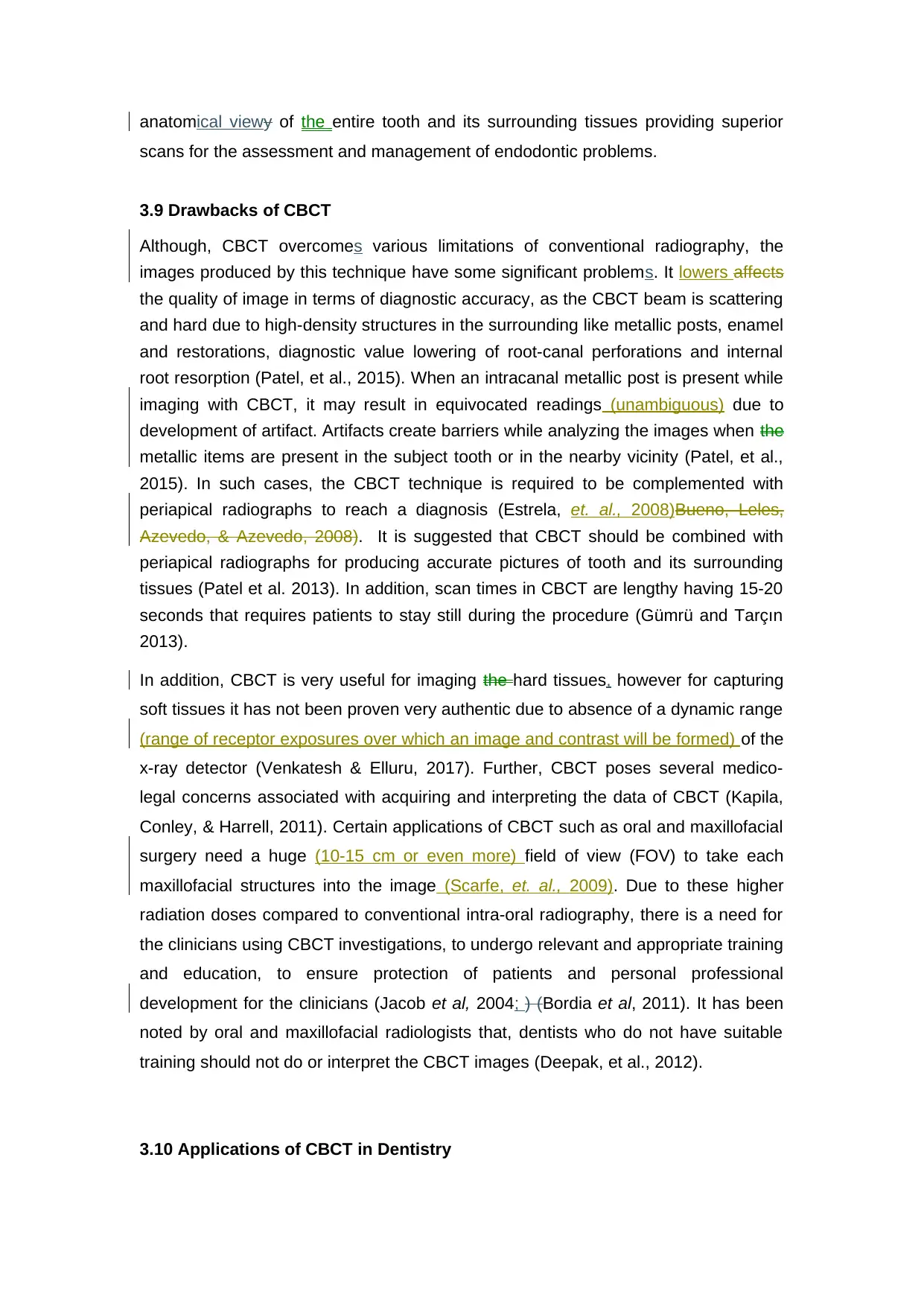
anatomical viewy of the entire tooth and its surrounding tissues providing superior
scans for the assessment and management of endodontic problems.
3.9 Drawbacks of CBCT
Although, CBCT overcomes various limitations of conventional radiography, the
images produced by this technique have some significant problems. It lowers affects
the quality of image in terms of diagnostic accuracy, as the CBCT beam is scattering
and hard due to high-density structures in the surrounding like metallic posts, enamel
and restorations, diagnostic value lowering of root-canal perforations and internal
root resorption (Patel, et al., 2015). When an intracanal metallic post is present while
imaging with CBCT, it may result in equivocated readings (unambiguous) due to
development of artifact. Artifacts create barriers while analyzing the images when the
metallic items are present in the subject tooth or in the nearby vicinity (Patel, et al.,
2015). In such cases, the CBCT technique is required to be complemented with
periapical radiographs to reach a diagnosis (Estrela, et. al., 2008)Bueno, Leles,
Azevedo, & Azevedo, 2008). It is suggested that CBCT should be combined with
periapical radiographs for producing accurate pictures of tooth and its surrounding
tissues (Patel et al. 2013). In addition, scan times in CBCT are lengthy having 15-20
seconds that requires patients to stay still during the procedure (Gümrü and Tarçın
2013).
In addition, CBCT is very useful for imaging the hard tissues, however for capturing
soft tissues it has not been proven very authentic due to absence of a dynamic range
(range of receptor exposures over which an image and contrast will be formed) of the
x-ray detector (Venkatesh & Elluru, 2017). Further, CBCT poses several medico-
legal concerns associated with acquiring and interpreting the data of CBCT (Kapila,
Conley, & Harrell, 2011). Certain applications of CBCT such as oral and maxillofacial
surgery need a huge (10-15 cm or even more) field of view (FOV) to take each
maxillofacial structures into the image (Scarfe, et. al., 2009). Due to these higher
radiation doses compared to conventional intra-oral radiography, there is a need for
the clinicians using CBCT investigations, to undergo relevant and appropriate training
and education, to ensure protection of patients and personal professional
development for the clinicians (Jacob et al, 2004; ) (Bordia et al, 2011). It has been
noted by oral and maxillofacial radiologists that, dentists who do not have suitable
training should not do or interpret the CBCT images (Deepak, et al., 2012).
3.10 Applications of CBCT in Dentistry
scans for the assessment and management of endodontic problems.
3.9 Drawbacks of CBCT
Although, CBCT overcomes various limitations of conventional radiography, the
images produced by this technique have some significant problems. It lowers affects
the quality of image in terms of diagnostic accuracy, as the CBCT beam is scattering
and hard due to high-density structures in the surrounding like metallic posts, enamel
and restorations, diagnostic value lowering of root-canal perforations and internal
root resorption (Patel, et al., 2015). When an intracanal metallic post is present while
imaging with CBCT, it may result in equivocated readings (unambiguous) due to
development of artifact. Artifacts create barriers while analyzing the images when the
metallic items are present in the subject tooth or in the nearby vicinity (Patel, et al.,
2015). In such cases, the CBCT technique is required to be complemented with
periapical radiographs to reach a diagnosis (Estrela, et. al., 2008)Bueno, Leles,
Azevedo, & Azevedo, 2008). It is suggested that CBCT should be combined with
periapical radiographs for producing accurate pictures of tooth and its surrounding
tissues (Patel et al. 2013). In addition, scan times in CBCT are lengthy having 15-20
seconds that requires patients to stay still during the procedure (Gümrü and Tarçın
2013).
In addition, CBCT is very useful for imaging the hard tissues, however for capturing
soft tissues it has not been proven very authentic due to absence of a dynamic range
(range of receptor exposures over which an image and contrast will be formed) of the
x-ray detector (Venkatesh & Elluru, 2017). Further, CBCT poses several medico-
legal concerns associated with acquiring and interpreting the data of CBCT (Kapila,
Conley, & Harrell, 2011). Certain applications of CBCT such as oral and maxillofacial
surgery need a huge (10-15 cm or even more) field of view (FOV) to take each
maxillofacial structures into the image (Scarfe, et. al., 2009). Due to these higher
radiation doses compared to conventional intra-oral radiography, there is a need for
the clinicians using CBCT investigations, to undergo relevant and appropriate training
and education, to ensure protection of patients and personal professional
development for the clinicians (Jacob et al, 2004; ) (Bordia et al, 2011). It has been
noted by oral and maxillofacial radiologists that, dentists who do not have suitable
training should not do or interpret the CBCT images (Deepak, et al., 2012).
3.10 Applications of CBCT in Dentistry
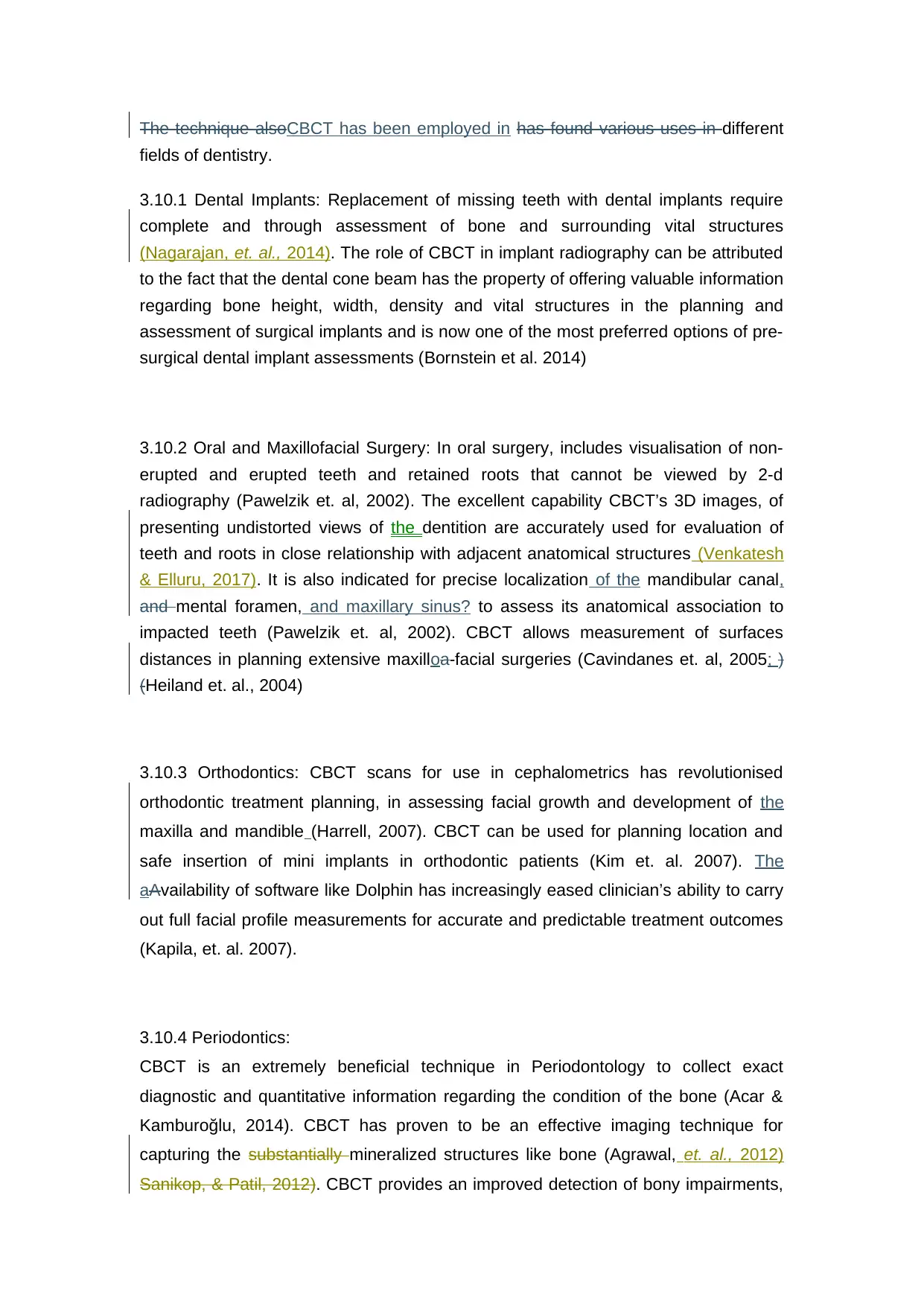
The technique alsoCBCT has been employed in has found various uses in different
fields of dentistry.
3.10.1 Dental Implants: Replacement of missing teeth with dental implants require
complete and through assessment of bone and surrounding vital structures
(Nagarajan, et. al., 2014). The role of CBCT in implant radiography can be attributed
to the fact that the dental cone beam has the property of offering valuable information
regarding bone height, width, density and vital structures in the planning and
assessment of surgical implants and is now one of the most preferred options of pre-
surgical dental implant assessments (Bornstein et al. 2014)
3.10.2 Oral and Maxillofacial Surgery: In oral surgery, includes visualisation of non-
erupted and erupted teeth and retained roots that cannot be viewed by 2-d
radiography (Pawelzik et. al, 2002). The excellent capability CBCT’s 3D images, of
presenting undistorted views of the dentition are accurately used for evaluation of
teeth and roots in close relationship with adjacent anatomical structures (Venkatesh
& Elluru, 2017). It is also indicated for precise localization of the mandibular canal,
and mental foramen, and maxillary sinus? to assess its anatomical association to
impacted teeth (Pawelzik et. al, 2002). CBCT allows measurement of surfaces
distances in planning extensive maxilloa-facial surgeries (Cavindanes et. al, 2005; )
(Heiland et. al., 2004)
3.10.3 Orthodontics: CBCT scans for use in cephalometrics has revolutionised
orthodontic treatment planning, in assessing facial growth and development of the
maxilla and mandible (Harrell, 2007). CBCT can be used for planning location and
safe insertion of mini implants in orthodontic patients (Kim et. al. 2007). The
aAvailability of software like Dolphin has increasingly eased clinician’s ability to carry
out full facial profile measurements for accurate and predictable treatment outcomes
(Kapila, et. al. 2007).
3.10.4 Periodontics:
CBCT is an extremely beneficial technique in Periodontology to collect exact
diagnostic and quantitative information regarding the condition of the bone (Acar &
Kamburoğlu, 2014). CBCT has proven to be an effective imaging technique for
capturing the substantially mineralized structures like bone (Agrawal, et. al., 2012)
Sanikop, & Patil, 2012). CBCT provides an improved detection of bony impairments,
fields of dentistry.
3.10.1 Dental Implants: Replacement of missing teeth with dental implants require
complete and through assessment of bone and surrounding vital structures
(Nagarajan, et. al., 2014). The role of CBCT in implant radiography can be attributed
to the fact that the dental cone beam has the property of offering valuable information
regarding bone height, width, density and vital structures in the planning and
assessment of surgical implants and is now one of the most preferred options of pre-
surgical dental implant assessments (Bornstein et al. 2014)
3.10.2 Oral and Maxillofacial Surgery: In oral surgery, includes visualisation of non-
erupted and erupted teeth and retained roots that cannot be viewed by 2-d
radiography (Pawelzik et. al, 2002). The excellent capability CBCT’s 3D images, of
presenting undistorted views of the dentition are accurately used for evaluation of
teeth and roots in close relationship with adjacent anatomical structures (Venkatesh
& Elluru, 2017). It is also indicated for precise localization of the mandibular canal,
and mental foramen, and maxillary sinus? to assess its anatomical association to
impacted teeth (Pawelzik et. al, 2002). CBCT allows measurement of surfaces
distances in planning extensive maxilloa-facial surgeries (Cavindanes et. al, 2005; )
(Heiland et. al., 2004)
3.10.3 Orthodontics: CBCT scans for use in cephalometrics has revolutionised
orthodontic treatment planning, in assessing facial growth and development of the
maxilla and mandible (Harrell, 2007). CBCT can be used for planning location and
safe insertion of mini implants in orthodontic patients (Kim et. al. 2007). The
aAvailability of software like Dolphin has increasingly eased clinician’s ability to carry
out full facial profile measurements for accurate and predictable treatment outcomes
(Kapila, et. al. 2007).
3.10.4 Periodontics:
CBCT is an extremely beneficial technique in Periodontology to collect exact
diagnostic and quantitative information regarding the condition of the bone (Acar &
Kamburoğlu, 2014). CBCT has proven to be an effective imaging technique for
capturing the substantially mineralized structures like bone (Agrawal, et. al., 2012)
Sanikop, & Patil, 2012). CBCT provides an improved detection of bony impairments,
⊘ This is a preview!⊘
Do you want full access?
Subscribe today to unlock all pages.

Trusted by 1+ million students worldwide
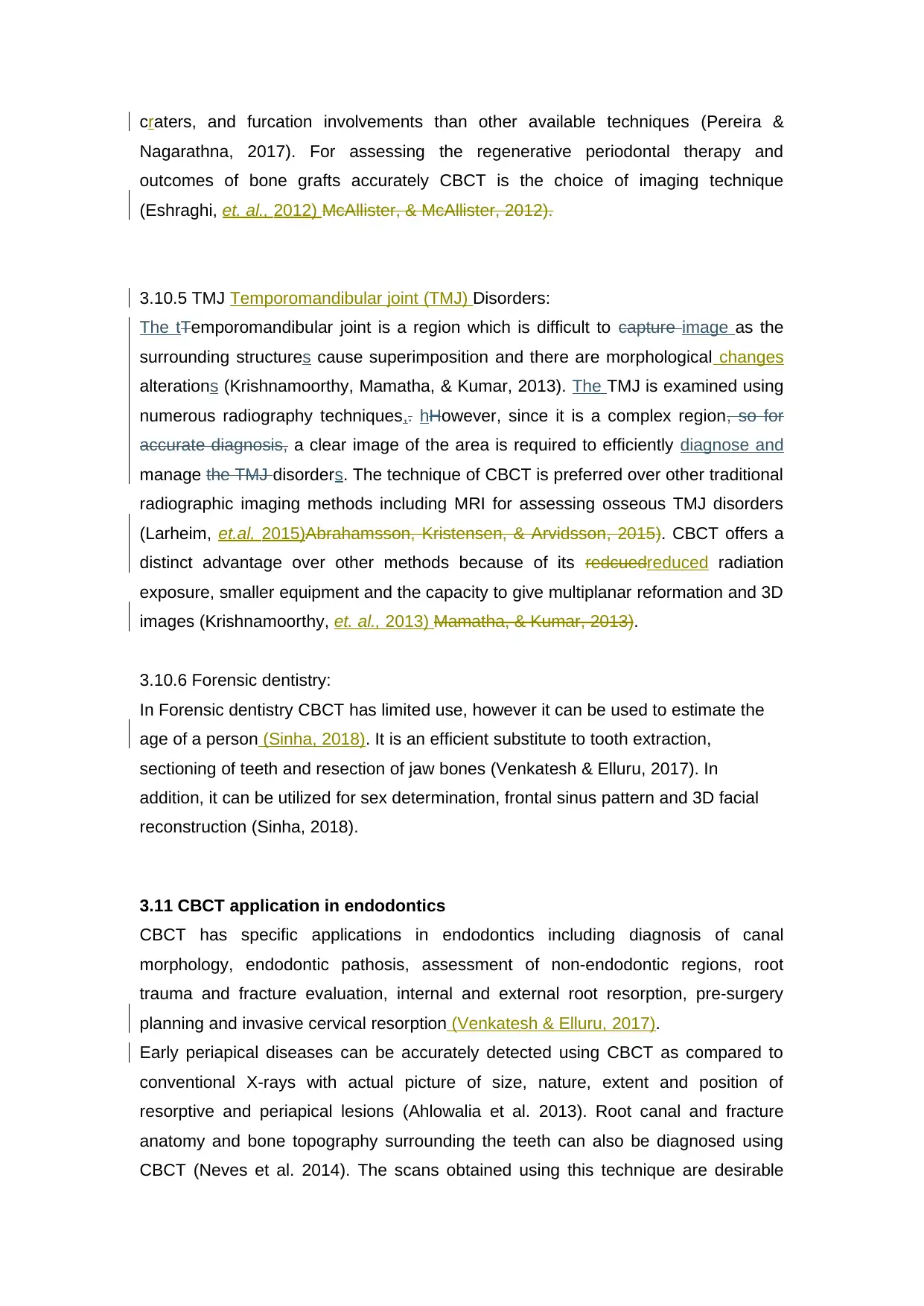
craters, and furcation involvements than other available techniques (Pereira &
Nagarathna, 2017). For assessing the regenerative periodontal therapy and
outcomes of bone grafts accurately CBCT is the choice of imaging technique
(Eshraghi, et. al., 2012) McAllister, & McAllister, 2012).
3.10.5 TMJ Temporomandibular joint (TMJ) Disorders:
The tTemporomandibular joint is a region which is difficult to capture image as the
surrounding structures cause superimposition and there are morphological changes
alterations (Krishnamoorthy, Mamatha, & Kumar, 2013). The TMJ is examined using
numerous radiography techniques,. hHowever, since it is a complex region, so for
accurate diagnosis, a clear image of the area is required to efficiently diagnose and
manage the TMJ disorders. The technique of CBCT is preferred over other traditional
radiographic imaging methods including MRI for assessing osseous TMJ disorders
(Larheim, et.al, 2015)Abrahamsson, Kristensen, & Arvidsson, 2015). CBCT offers a
distinct advantage over other methods because of its redcuedreduced radiation
exposure, smaller equipment and the capacity to give multiplanar reformation and 3D
images (Krishnamoorthy, et. al., 2013) Mamatha, & Kumar, 2013).
3.10.6 Forensic dentistry:
In Forensic dentistry CBCT has limited use, however it can be used to estimate the
age of a person (Sinha, 2018). It is an efficient substitute to tooth extraction,
sectioning of teeth and resection of jaw bones (Venkatesh & Elluru, 2017). In
addition, it can be utilized for sex determination, frontal sinus pattern and 3D facial
reconstruction (Sinha, 2018).
3.11 CBCT application in endodontics
CBCT has specific applications in endodontics including diagnosis of canal
morphology, endodontic pathosis, assessment of non-endodontic regions, root
trauma and fracture evaluation, internal and external root resorption, pre-surgery
planning and invasive cervical resorption (Venkatesh & Elluru, 2017).
Early periapical diseases can be accurately detected using CBCT as compared to
conventional X-rays with actual picture of size, nature, extent and position of
resorptive and periapical lesions (Ahlowalia et al. 2013). Root canal and fracture
anatomy and bone topography surrounding the teeth can also be diagnosed using
CBCT (Neves et al. 2014). The scans obtained using this technique are desirable
Nagarathna, 2017). For assessing the regenerative periodontal therapy and
outcomes of bone grafts accurately CBCT is the choice of imaging technique
(Eshraghi, et. al., 2012) McAllister, & McAllister, 2012).
3.10.5 TMJ Temporomandibular joint (TMJ) Disorders:
The tTemporomandibular joint is a region which is difficult to capture image as the
surrounding structures cause superimposition and there are morphological changes
alterations (Krishnamoorthy, Mamatha, & Kumar, 2013). The TMJ is examined using
numerous radiography techniques,. hHowever, since it is a complex region, so for
accurate diagnosis, a clear image of the area is required to efficiently diagnose and
manage the TMJ disorders. The technique of CBCT is preferred over other traditional
radiographic imaging methods including MRI for assessing osseous TMJ disorders
(Larheim, et.al, 2015)Abrahamsson, Kristensen, & Arvidsson, 2015). CBCT offers a
distinct advantage over other methods because of its redcuedreduced radiation
exposure, smaller equipment and the capacity to give multiplanar reformation and 3D
images (Krishnamoorthy, et. al., 2013) Mamatha, & Kumar, 2013).
3.10.6 Forensic dentistry:
In Forensic dentistry CBCT has limited use, however it can be used to estimate the
age of a person (Sinha, 2018). It is an efficient substitute to tooth extraction,
sectioning of teeth and resection of jaw bones (Venkatesh & Elluru, 2017). In
addition, it can be utilized for sex determination, frontal sinus pattern and 3D facial
reconstruction (Sinha, 2018).
3.11 CBCT application in endodontics
CBCT has specific applications in endodontics including diagnosis of canal
morphology, endodontic pathosis, assessment of non-endodontic regions, root
trauma and fracture evaluation, internal and external root resorption, pre-surgery
planning and invasive cervical resorption (Venkatesh & Elluru, 2017).
Early periapical diseases can be accurately detected using CBCT as compared to
conventional X-rays with actual picture of size, nature, extent and position of
resorptive and periapical lesions (Ahlowalia et al. 2013). Root canal and fracture
anatomy and bone topography surrounding the teeth can also be diagnosed using
CBCT (Neves et al. 2014). The scans obtained using this technique are desirable
Paraphrase This Document
Need a fresh take? Get an instant paraphrase of this document with our AI Paraphraser
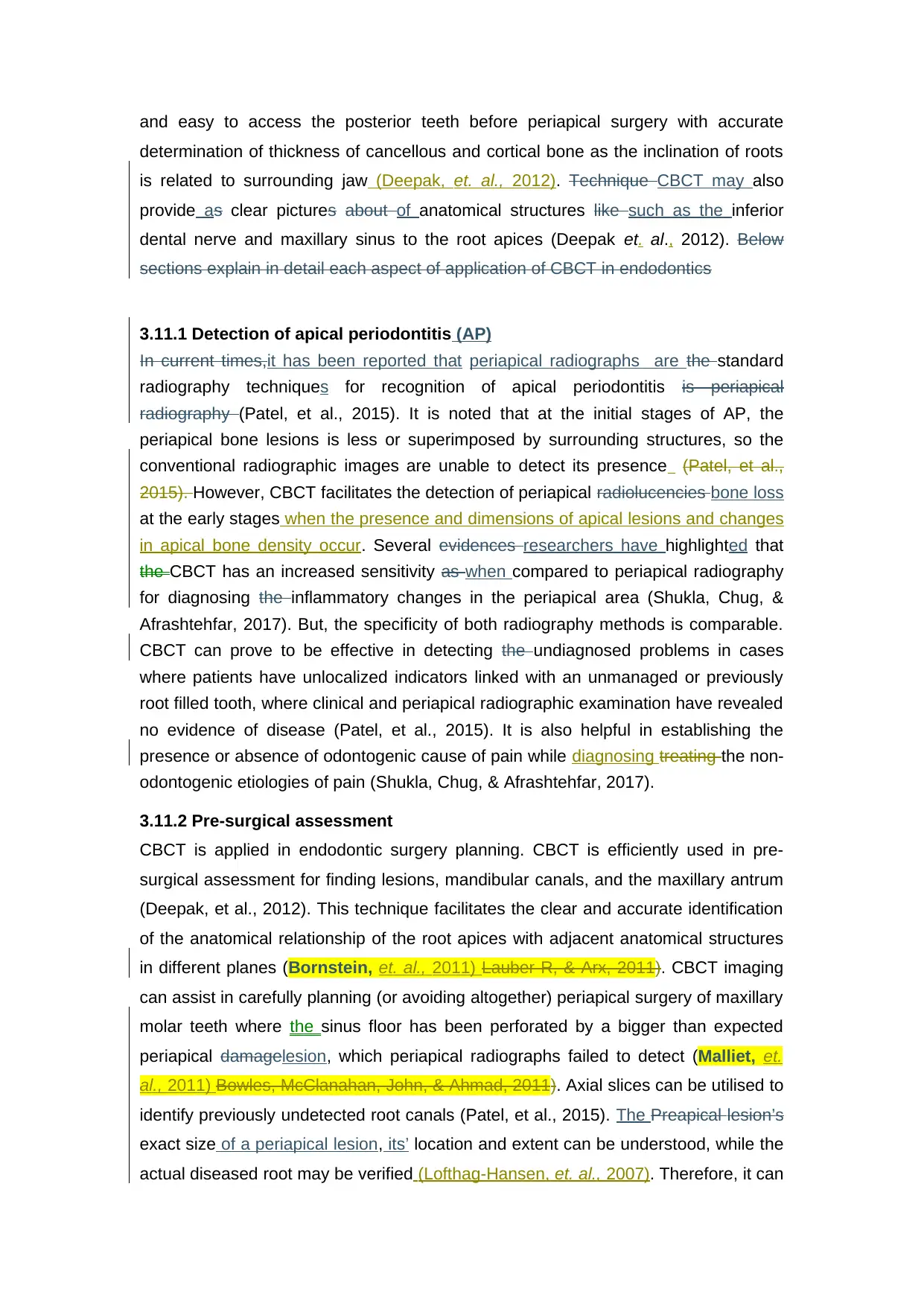
and easy to access the posterior teeth before periapical surgery with accurate
determination of thickness of cancellous and cortical bone as the inclination of roots
is related to surrounding jaw (Deepak, et. al., 2012). Technique CBCT may also
provide as clear pictures about of anatomical structures like such as the inferior
dental nerve and maxillary sinus to the root apices (Deepak et. al., 2012). Below
sections explain in detail each aspect of application of CBCT in endodontics
3.11.1 Detection of apical periodontitis (AP)
In current times,it has been reported that periapical radiographs are the standard
radiography techniques for recognition of apical periodontitis is periapical
radiography (Patel, et al., 2015). It is noted that at the initial stages of AP, the
periapical bone lesions is less or superimposed by surrounding structures, so the
conventional radiographic images are unable to detect its presence (Patel, et al.,
2015). However, CBCT facilitates the detection of periapical radiolucencies bone loss
at the early stages when the presence and dimensions of apical lesions and changes
in apical bone density occur. Several evidences researchers have highlighted that
the CBCT has an increased sensitivity as when compared to periapical radiography
for diagnosing the inflammatory changes in the periapical area (Shukla, Chug, &
Afrashtehfar, 2017). But, the specificity of both radiography methods is comparable.
CBCT can prove to be effective in detecting the undiagnosed problems in cases
where patients have unlocalized indicators linked with an unmanaged or previously
root filled tooth, where clinical and periapical radiographic examination have revealed
no evidence of disease (Patel, et al., 2015). It is also helpful in establishing the
presence or absence of odontogenic cause of pain while diagnosing treating the non-
odontogenic etiologies of pain (Shukla, Chug, & Afrashtehfar, 2017).
3.11.2 Pre-surgical assessment
CBCT is applied in endodontic surgery planning. CBCT is efficiently used in pre-
surgical assessment for finding lesions, mandibular canals, and the maxillary antrum
(Deepak, et al., 2012). This technique facilitates the clear and accurate identification
of the anatomical relationship of the root apices with adjacent anatomical structures
in different planes (Bornstein, et. al., 2011) Lauber R, & Arx, 2011). CBCT imaging
can assist in carefully planning (or avoiding altogether) periapical surgery of maxillary
molar teeth where the sinus floor has been perforated by a bigger than expected
periapical damagelesion, which periapical radiographs failed to detect (Malliet, et.
al., 2011) Bowles, McClanahan, John, & Ahmad, 2011). Axial slices can be utilised to
identify previously undetected root canals (Patel, et al., 2015). The Preapical lesion’s
exact size of a periapical lesion, its’ location and extent can be understood, while the
actual diseased root may be verified (Lofthag-Hansen, et. al., 2007). Therefore, it can
determination of thickness of cancellous and cortical bone as the inclination of roots
is related to surrounding jaw (Deepak, et. al., 2012). Technique CBCT may also
provide as clear pictures about of anatomical structures like such as the inferior
dental nerve and maxillary sinus to the root apices (Deepak et. al., 2012). Below
sections explain in detail each aspect of application of CBCT in endodontics
3.11.1 Detection of apical periodontitis (AP)
In current times,it has been reported that periapical radiographs are the standard
radiography techniques for recognition of apical periodontitis is periapical
radiography (Patel, et al., 2015). It is noted that at the initial stages of AP, the
periapical bone lesions is less or superimposed by surrounding structures, so the
conventional radiographic images are unable to detect its presence (Patel, et al.,
2015). However, CBCT facilitates the detection of periapical radiolucencies bone loss
at the early stages when the presence and dimensions of apical lesions and changes
in apical bone density occur. Several evidences researchers have highlighted that
the CBCT has an increased sensitivity as when compared to periapical radiography
for diagnosing the inflammatory changes in the periapical area (Shukla, Chug, &
Afrashtehfar, 2017). But, the specificity of both radiography methods is comparable.
CBCT can prove to be effective in detecting the undiagnosed problems in cases
where patients have unlocalized indicators linked with an unmanaged or previously
root filled tooth, where clinical and periapical radiographic examination have revealed
no evidence of disease (Patel, et al., 2015). It is also helpful in establishing the
presence or absence of odontogenic cause of pain while diagnosing treating the non-
odontogenic etiologies of pain (Shukla, Chug, & Afrashtehfar, 2017).
3.11.2 Pre-surgical assessment
CBCT is applied in endodontic surgery planning. CBCT is efficiently used in pre-
surgical assessment for finding lesions, mandibular canals, and the maxillary antrum
(Deepak, et al., 2012). This technique facilitates the clear and accurate identification
of the anatomical relationship of the root apices with adjacent anatomical structures
in different planes (Bornstein, et. al., 2011) Lauber R, & Arx, 2011). CBCT imaging
can assist in carefully planning (or avoiding altogether) periapical surgery of maxillary
molar teeth where the sinus floor has been perforated by a bigger than expected
periapical damagelesion, which periapical radiographs failed to detect (Malliet, et.
al., 2011) Bowles, McClanahan, John, & Ahmad, 2011). Axial slices can be utilised to
identify previously undetected root canals (Patel, et al., 2015). The Preapical lesion’s
exact size of a periapical lesion, its’ location and extent can be understood, while the
actual diseased root may be verified (Lofthag-Hansen, et. al., 2007). Therefore, it can
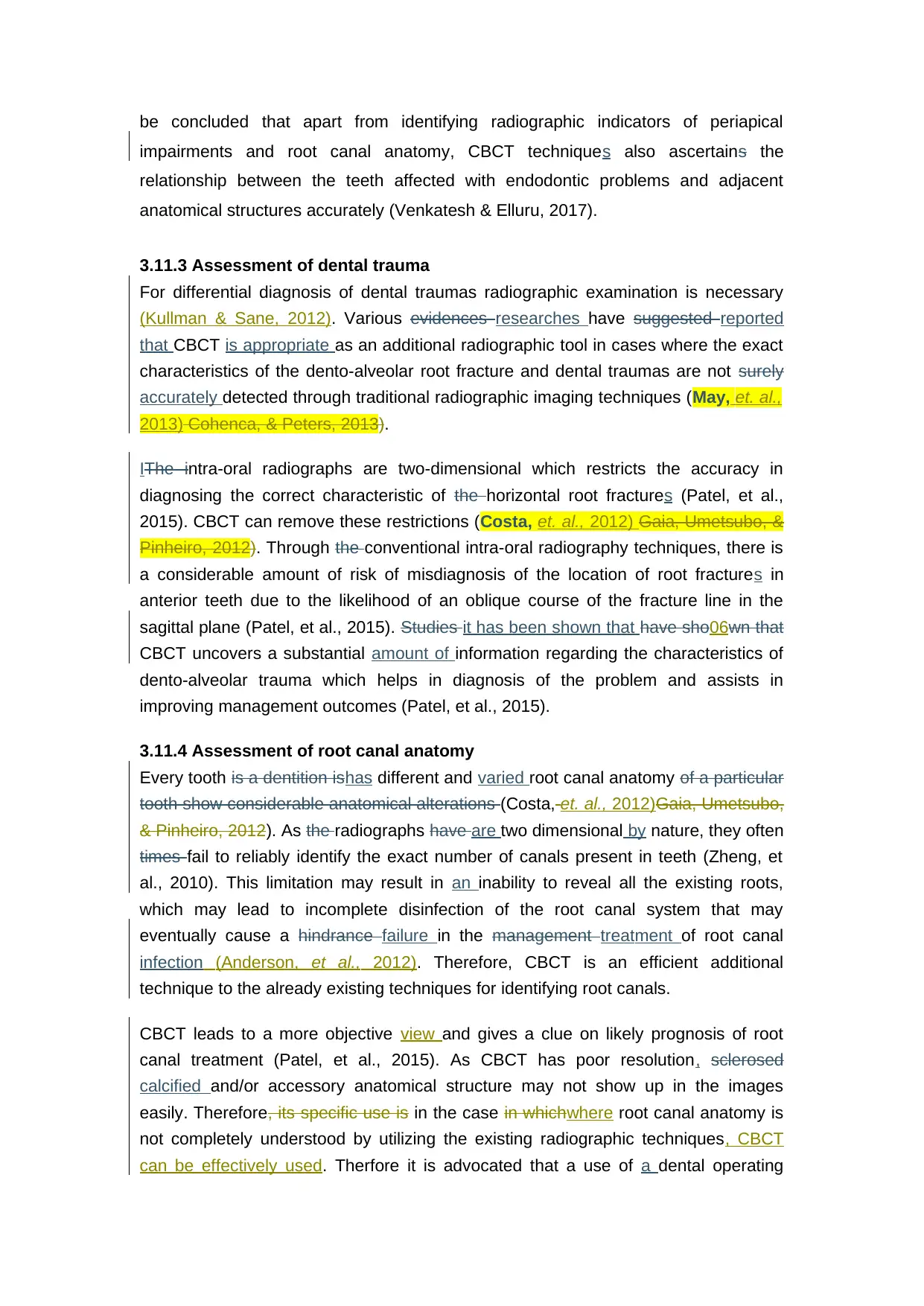
be concluded that apart from identifying radiographic indicators of periapical
impairments and root canal anatomy, CBCT techniques also ascertains the
relationship between the teeth affected with endodontic problems and adjacent
anatomical structures accurately (Venkatesh & Elluru, 2017).
3.11.3 Assessment of dental trauma
For differential diagnosis of dental traumas radiographic examination is necessary
(Kullman & Sane, 2012). Various evidences researches have suggested reported
that CBCT is appropriate as an additional radiographic tool in cases where the exact
characteristics of the dento-alveolar root fracture and dental traumas are not surely
accurately detected through traditional radiographic imaging techniques (May, et. al.,
2013) Cohenca, & Peters, 2013).
IThe intra-oral radiographs are two-dimensional which restricts the accuracy in
diagnosing the correct characteristic of the horizontal root fractures (Patel, et al.,
2015). CBCT can remove these restrictions (Costa, et. al., 2012) Gaia, Umetsubo, &
Pinheiro, 2012). Through the conventional intra-oral radiography techniques, there is
a considerable amount of risk of misdiagnosis of the location of root fractures in
anterior teeth due to the likelihood of an oblique course of the fracture line in the
sagittal plane (Patel, et al., 2015). Studies it has been shown that have sho06wn that
CBCT uncovers a substantial amount of information regarding the characteristics of
dento-alveolar trauma which helps in diagnosis of the problem and assists in
improving management outcomes (Patel, et al., 2015).
3.11.4 Assessment of root canal anatomy
Every tooth is a dentition ishas different and varied root canal anatomy of a particular
tooth show considerable anatomical alterations (Costa, et. al., 2012)Gaia, Umetsubo,
& Pinheiro, 2012). As the radiographs have are two dimensional by nature, they often
times fail to reliably identify the exact number of canals present in teeth (Zheng, et
al., 2010). This limitation may result in an inability to reveal all the existing roots,
which may lead to incomplete disinfection of the root canal system that may
eventually cause a hindrance failure in the management treatment of root canal
infection (Anderson, et al., 2012). Therefore, CBCT is an efficient additional
technique to the already existing techniques for identifying root canals.
CBCT leads to a more objective view and gives a clue on likely prognosis of root
canal treatment (Patel, et al., 2015). As CBCT has poor resolution, sclerosed
calcified and/or accessory anatomical structure may not show up in the images
easily. Therefore, its specific use is in the case in whichwhere root canal anatomy is
not completely understood by utilizing the existing radiographic techniques, CBCT
can be effectively used. Therfore it is advocated that a use of a dental operating
impairments and root canal anatomy, CBCT techniques also ascertains the
relationship between the teeth affected with endodontic problems and adjacent
anatomical structures accurately (Venkatesh & Elluru, 2017).
3.11.3 Assessment of dental trauma
For differential diagnosis of dental traumas radiographic examination is necessary
(Kullman & Sane, 2012). Various evidences researches have suggested reported
that CBCT is appropriate as an additional radiographic tool in cases where the exact
characteristics of the dento-alveolar root fracture and dental traumas are not surely
accurately detected through traditional radiographic imaging techniques (May, et. al.,
2013) Cohenca, & Peters, 2013).
IThe intra-oral radiographs are two-dimensional which restricts the accuracy in
diagnosing the correct characteristic of the horizontal root fractures (Patel, et al.,
2015). CBCT can remove these restrictions (Costa, et. al., 2012) Gaia, Umetsubo, &
Pinheiro, 2012). Through the conventional intra-oral radiography techniques, there is
a considerable amount of risk of misdiagnosis of the location of root fractures in
anterior teeth due to the likelihood of an oblique course of the fracture line in the
sagittal plane (Patel, et al., 2015). Studies it has been shown that have sho06wn that
CBCT uncovers a substantial amount of information regarding the characteristics of
dento-alveolar trauma which helps in diagnosis of the problem and assists in
improving management outcomes (Patel, et al., 2015).
3.11.4 Assessment of root canal anatomy
Every tooth is a dentition ishas different and varied root canal anatomy of a particular
tooth show considerable anatomical alterations (Costa, et. al., 2012)Gaia, Umetsubo,
& Pinheiro, 2012). As the radiographs have are two dimensional by nature, they often
times fail to reliably identify the exact number of canals present in teeth (Zheng, et
al., 2010). This limitation may result in an inability to reveal all the existing roots,
which may lead to incomplete disinfection of the root canal system that may
eventually cause a hindrance failure in the management treatment of root canal
infection (Anderson, et al., 2012). Therefore, CBCT is an efficient additional
technique to the already existing techniques for identifying root canals.
CBCT leads to a more objective view and gives a clue on likely prognosis of root
canal treatment (Patel, et al., 2015). As CBCT has poor resolution, sclerosed
calcified and/or accessory anatomical structure may not show up in the images
easily. Therefore, its specific use is in the case in whichwhere root canal anatomy is
not completely understood by utilizing the existing radiographic techniques, CBCT
can be effectively used. Therfore it is advocated that a use of a dental operating
⊘ This is a preview!⊘
Do you want full access?
Subscribe today to unlock all pages.

Trusted by 1+ million students worldwide
1 out of 25
Related Documents
Your All-in-One AI-Powered Toolkit for Academic Success.
+13062052269
info@desklib.com
Available 24*7 on WhatsApp / Email
![[object Object]](/_next/static/media/star-bottom.7253800d.svg)
Unlock your academic potential
Copyright © 2020–2025 A2Z Services. All Rights Reserved. Developed and managed by ZUCOL.





